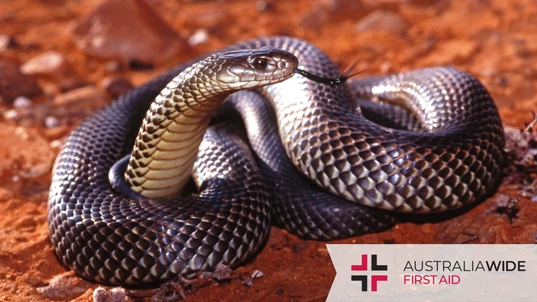The Formidable King Brown Snake

Bites and Stings

The King brown snake, also known as the Mulga snake, can be found in natural and urban environments throughout Australia. Not only is their venom highly toxic, but it can also be injected in enormous quantities, which makes them one of Australia's deadliest snakes.
The King brown snake, otherwise known as the Mulga snake, has the widest distribution of any Australian snake. They also have highly potent venom that can be injected in enormous quantities. In this article, we will help you become better acquainted with the King brown and snake bite first aid. We also cover snake bites in our general and childcare first aid courses - head to our website to find and enrol at a training location near you today.Appearance
- They generally average around 2 metres, though the largest specimen reliably measured was 3.3 metres
- The scales on their back and sides are usually darkly coloured at the point of attachment and yellowish white to greenish yellow at the tip, which gives a reticulated effect
- The scales on their belly can range from cream to salmon, typically with smatterings of orange
Habitat and Distribution
The King brown is the most widely distributed snake in Australia. They can be found throughout the mainland, save for the furthermost southern and south-eastern parts. They can thrive in a wide variety of habitats, including:- Closed tropical monsoon forest
- Grassland
- Shrubland
- Sandy desert
- Highly disturbed areas, such as wheat fields
- Disused animal burrows
- Soil cracks
- Rock cavities
- Large rocks
- Fallen timber
Feeding and Behaviours
The Australia king brown predominantly feeds on vertebrate prey, including:- Frogs
- Reptiles and reptile eggs
- Birds and bird eggs
- Small mammals
Danger and First Aid
When threatened, the King brown will thrash its head and neck from side to side and hiss loudly. If pressed further, it will subsequently lash out and bite its victim, even hanging on and chewing to express an enormous quantity of venom. Their venom is highly toxic and can attack nerve cells, blood cells, and muscle. As such, any bite from a King brown should be treated as a medical emergency with the Pressure Immobilisation Technique. Head to our article on snake bite first aid for more information. Despite their name, the King brown is a member of the black snake genus and so their bites necessitate Black Snake Antivenom.Final Thoughts
It is important to remember, snakes will never go out of their way to attack you. As such, the best way to avoid a snake bite is to refrain from approaching, capturing, or killing snakes at home or in the wild. If you need a snake relocated from your property, contact a professional snake catcher. And for hands-on experience with managing snake bites, enrol in one of our general or childcare first aid courses. We have training locations in every state, capital city, and major town throughout Australia - head to our website to find and enrol at a training location near you today.
Originally published at
https://www.australiawidefirstaid.com.au/resources/king-brown-snake
as part of the Australia Wide First Aid Articles Library









